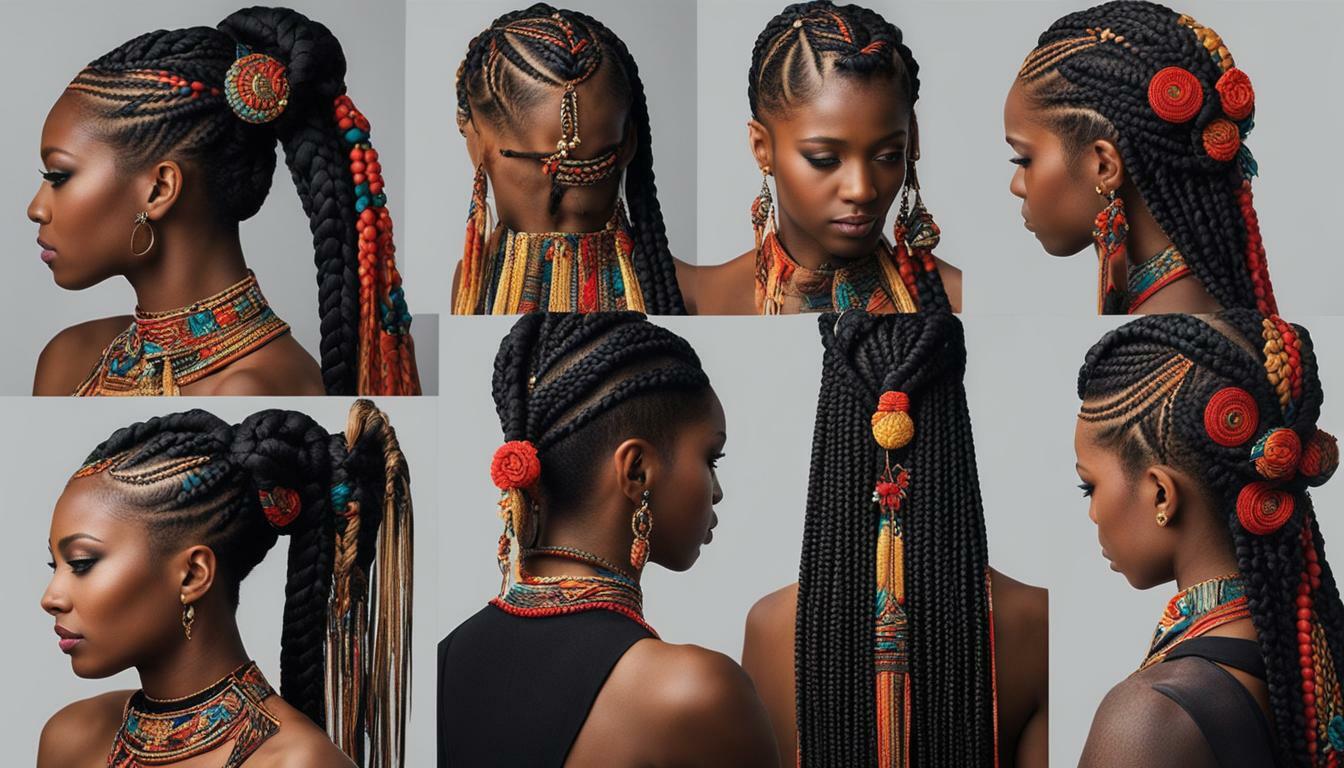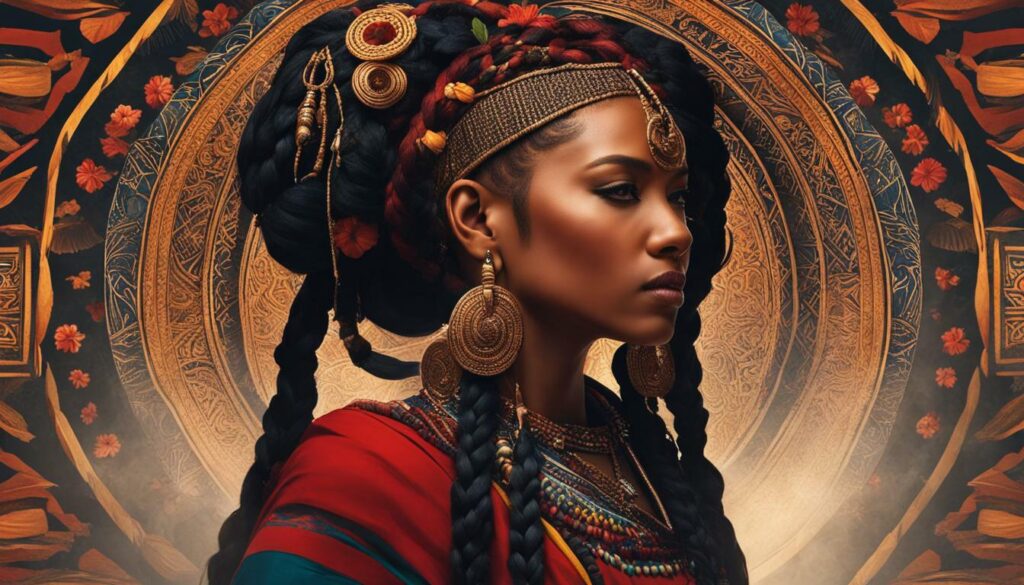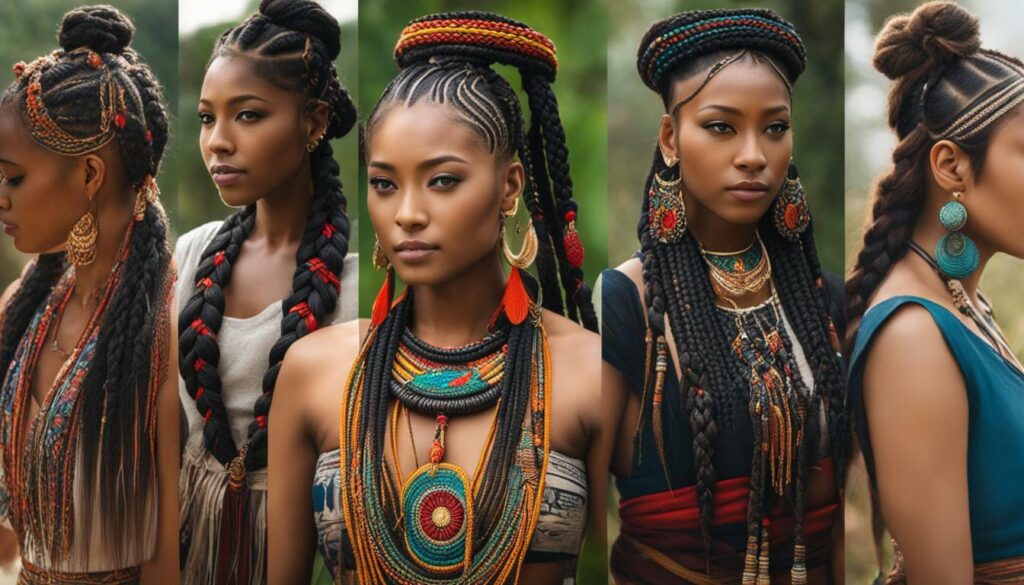
Tribal braids hold deep cultural significance and carry a rich history that spans across different African cultures. These braiding patterns, originating from various communities in Africa, offer a unique way to express identity, unity, and pride. With different textures, designs, and adornments, tribal braids can boost confidence and showcase the beauty of diverse hair types.
In African communities, tribal braids are more than just a hairstyle. They are steeped in symbolism and serve multiple purposes. For religious gatherings, tribal braids are worn as a form of reverence and devotion. They are also a symbol of strength and unity within communities, representing the bond between individuals and their shared heritage.
Moreover, tribal braids are a powerful way to express cultural pride and identity. These braiding styles are a testament to the rich history and traditions of African cultures, often passed down through generations. By wearing tribal braids, individuals celebrate their heritage and honor the ancestral knowledge and craftsmanship behind these intricate hair designs.
There are various types of tribal braids, each with its own unique characteristics. Fulani braids, cornrows, box braids, and Ghana braids are some examples of these culturally significant hairstyles. These braiding patterns not only enhance the aesthetics of the hair but also serve as a tangible connection to cultural roots.
Key Takeaways:
- Tribal braids carry deep cultural significance and are rooted in different African cultures.
- They symbolize strength, unity, pride, and cultural identity.
- Fulani braids, cornrows, box braids, and Ghana braids are examples of popular tribal braiding styles.
- Maintaining tribal braids involves washing every three to four weeks and protecting them with silk or satin scarves and moisturizing the scalp.
- Finding a qualified stylist through an online booking app can help achieve the desired tribal braid style.
Cultural Importance and Symbolism of Tribal Braids
Tribal braids have long been revered for their cultural importance, serving as more than just a fashionable hairstyle but as a powerful symbol of heritage and tradition. These braids hold deep meaning within various African communities and are an expression of identity, unity, and pride.
Throughout history, traditional tribal braids have been worn for religious gatherings, rites of passage, and special occasions. They symbolize strength, resilience, and the interconnectedness of African cultures. Each braiding pattern tells a unique story, reflecting the history and traditions of the people who wear them.
Examples of traditional tribal braids include Fulani braids, cornrows, box braids, and Ghana braids. These braiding styles vary in complexity, design, and adornments, but all share a common thread of cultural significance. Fulani braids, for instance, are often adorned with beads and cowrie shells, representing adornment, prosperity, and spirituality.

When wearing tribal braids, it is important to maintain and protect the hair to ensure longevity and preserve the cultural significance of the style. Regular washing every three to four weeks, deep conditioning, and keeping the scalp moisturized are essential steps in the maintenance process. It is also recommended to use silk or satin scarves at night to prevent frizz and breakage.
Types of Tribal Braids:
- Fulani braids: characterized by a center parting and cornrows that extend to the back, often adorned with beads and shells.
- Zig-zag braids: braids that create a zig-zag pattern across the scalp, adding a unique touch to the overall look.
- Side-part tribal braids: braids styled with a side parting, offering versatility and different styling options.
- Jumbo tribal braids: large and chunky braids that create a bold and statement-making hairstyle.
By embracing tribal braids, individuals not only celebrate their cultural heritage but also contribute to the preservation and appreciation of African traditions. Whether it’s in the intricate patterns, vibrant adornments, or the unity they represent, tribal braids are a timeless symbol of cultural pride and empowerment.
| Benefits of Tribal Braids | Considerations |
|---|---|
|
|
Types of Tribal Braids and Maintenance Tips
From Fulani braids to cornrows and beyond, tribal braids come in various forms that showcase the diversity of African cultures and allow individuals to express their unique identities. These braiding styles have been passed down through generations, each with its own distinct characteristics and significance. Here are some popular types of tribal braids and tips for maintaining them:
Fulani Braids
Fulani braids, also known as Bo braids or Alicia Keys braids, are characterized by their intricate patterns and cornrow base. They often feature delicate beadwork and jewelry, adding an extra element of beauty to the style. To maintain Fulani braids, it’s important to regularly moisturize your scalp and edges with a lightweight oil or leave-in conditioner. You can also use a satin or silk scarf to wrap your braids at night, minimizing frizz and preserving the style.
Cornrows
Cornrows are one of the most iconic and versatile types of tribal braids. They can be braided close to the scalp or styled in intricate designs. To keep your cornrows looking fresh, wash them every two to three weeks with a gentle shampoo and conditioner. Avoid using excessive tension when braiding, as this can lead to hair breakage. Applying a leave-in conditioner or hair oil can help nourish and protect your scalp.
Box Braids
Box braids are thick, three-strand braids that can be long or short, depending on your preference. They offer a stylish and low-maintenance option for those who want to protect their natural hair. To care for box braids, gently cleanse your scalp with a diluted shampoo and follow up with a moisturizing conditioner. It’s important to keep your scalp hydrated by applying a lightweight oil or leave-in conditioner. To prevent frizz, you can secure your braids with a satin or silk scarf while sleeping.
Remember, maintaining the health of your natural hair is essential when wearing any type of braids. Regularly moisturizing your scalp and edges, avoiding excessive tension, and protecting your hair at night will help prolong the life of your tribal braids and keep your hair healthy and strong.

Conclusion
Tribal braids are more than just a hairstyle – they are a celebration of culture, identity, and heritage. Whether you choose Fulani braids, cornrows, or box braids, each style carries its own meaning and symbolism. By embracing tribal braids, individuals can proudly showcase their African roots and express their unique personality. Remember to care for your tribal braids by following proper maintenance tips and seeking professional help when needed. With the right care, your tribal braids will not only look stunning but also serve as a powerful symbol of cultural pride.
| Type of Tribal Braids | Characteristic |
|---|---|
| Fulani Braids | Intricate patterns, cornrow base, beadwork and jewelry |
| Cornrows | Close to scalp, versatile designs |
| Box Braids | Thick, three-strand braids, long or short |
Conclusion
Exploring the cultural meaning and significance of tribal braids reveals a rich tapestry of history, identity, and pride that continues to influence and inspire hair artistry today.
Tribal braids, which originated from different cultures in Africa, offer a diverse range of textures, designs, and adornments that boost confidence and allow individuals to express their unique style. These braiding patterns, such as Fulani braids, cornrows, box braids, and Ghana braids, hold deep cultural significance and have been worn for various occasions throughout history.
For centuries, tribal braids have been used as a symbol of strength and unity within African communities. They have been worn during religious ceremonies, signifying a connection to spirituality and ancestral traditions. Tribal braids also serve as a powerful statement of pride, enabling individuals to embrace and showcase their cultural heritage.
Maintaining and protecting tribal braids is essential to ensure their longevity and keep your hair healthy. It is recommended to wash tribal braids every three to four weeks and take measures to keep the scalp moisturized. Additionally, using silk or satin scarves at night can help preserve the braids and prevent frizz. To achieve your desired tribal braid style, consider finding a qualified stylist through an online booking app who specializes in these distinctive braiding techniques.
FAQ
What do tribal braids mean?
Tribal braids refer to braiding patterns that originated from different cultures in Africa. They offer different textures, designs, and adornments to boost confidence.
What are some examples of tribal braids?
Examples of tribal braids include Fulani braids, cornrows, box braids, and Ghana braids.
What is the cultural importance and symbolism of tribal braids?
Tribal braids have cultural significance and have been worn for religious gatherings, as a symbol of strength and unity, and as a way to express pride and cultural identity.
What are the different types of tribal braids and maintenance tips?
There are various types of tribal braids, including Fulani braids, zig-zag braids, side-part tribal braids, and jumbo tribal braids. It is recommended to wash tribal braids every three to four weeks and to take measures to maintain and protect them, such as using silk or satin scarves at night and keeping the scalp moisturized.
How can I find a qualified stylist for tribal braids?
Finding a qualified stylist through an online booking app can help you achieve your desired tribal braid style.






